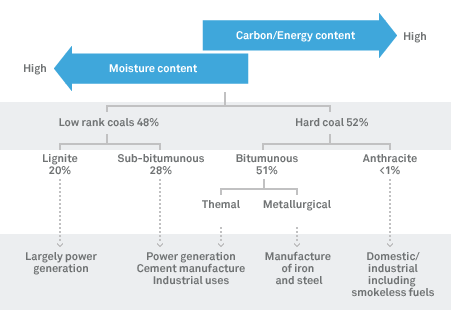Coal Rank
The degree of 'metamorphisrn' or coalification undergone by a coal, as it matures from peat to anthracite, has an important bearing on its physical and chemical properties, and is referred to as the 'rank' of the coal.

Layered between other sedimentary rocks, coal is found in seams ranging from less than a millimetre in thickness to many metres. Coal is composed mainly of carbon (50-98%), hydrogen (3-13%) and oxygen, and smaller amounts of nitrogen, sulphur and other elements. It also contains a little water and grains of inorganic matter that remain as a residue known as ash when coal is burnt.
Low rank coals, such as lignite and sub-bituminous coals, are typically softer, friable materials with a dull, earthy appearance; they are characterised by high moisture levels and a low carbon content, and hence a low energy content. Higher rank coals are typically harder and stronger and often have a black vitreous lustre. Increasing rank is accompanied by a rise in the carbon and energy contents and a decrease in the moisture content of the coal. Anthracite is at the top of the rank scale and has a correspondingly higher carbon and energy content and a lower level of moisture.
Coal Types
Geologists also classify coal types according to the organic debris, called macerals, from which the coal is formed. Macerals are identified (microscopically) by reflected light - the reflective or translucent properties of the coal indicating the individual component macerals and the way they have combined to form the coal.
Bituminous coals are dense black solids, frequently containing bands with a brilliant lustre. The carbon content of these coals ranges from 78 to 91 percent and the water content from 1.5 to 7 percent.
Sub-bituminous coals usually appear dull black and waxy. They have a carbon content between 71 and 77 percent and a moisture content of up to 10 percent and are used for electricity generation or can be converted to liquid and gaseous fuels.
Brown coals, found in Australia in Victoria's Latrobe Valley, are used for power generation but generally are uneconomic to transport because of their high moisture content. These coals are also susceptible to spontaneous combustion.
- Coal Mining
- |
- Coal Crusher
- |
- Coal Mill
- |
- Coal Classification
- Privacy Policy | © 2010 - 2011 SHANGHAI SHIBANG MACHINERY CO., LTD.
